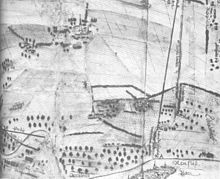Combahn
Combahn was a small independent village on the Rhine north of Beuel until the 19th century . Today it belongs to the Beuel-Mitte district of Bonn and is only unofficially referred to as the Combahnviertel .
location
Combahn originally consisted of two built-up areas. One was on the banks of the Rhine, around today's Rheinaustraße, the other southeast of it at the level of today's Friedrich-Breuer-Straße, i.e. in an area that today belongs to the center of Beuel.
history
The first known mention is from 1343 as kumban . The name is derived from the words Kumme for a valley and Ban for a heaped path.
Since the 17th century, a Gierponte Combahn connected Bonn on the other side of the Rhine. In 1784, a flood of the Rhine destroyed the entire bank development. Combahn belonged to the Vilicher Ländchen , which in turn belonged to Kurköln , while Beuel was part of the Bergisches Amt Löwenburg . In 1808 this border was abolished under French rule, the two places later belonged to the province of Jülich-Kleve-Berg and then the Rhine province , but still to different communities. In 1892 both were incorporated into the mayor's office in Vilich zu Beuel, which later became the city of Beuel, and after the municipal reform in 1969, Combahn belonged to Bonn like the rest of Beuel.
About 40% of the current development in the district dates from before 1918. Since the merger in 1892, Combahn had been developed under the Cologne city architect Hermann Joseph Stübben . In 1891 a terminus of the Bröltalbahn was built for Beuel in Combahn before the merger , the railway was shut down in 1967.
literature
- Frank Auffenberg: Cherry blossoms and town villas . In: General-Anzeiger Bonn March 19, 2008, p. 10.
- Carl Jakob Bachem : Beuel Chronicle. Timeline for the history of Bonn on the right bank of the Rhine. City of Bonn, Bonn 1989, ISBN 3-922832-06-7 , ( studies on the local history of the Bonn-Beuel district 26).
- Dieter Remig: The Combahnviertel : In: Bettina Bab (Red.): “The Beuel side is just the sunny side”. A historical reader . Bonn History Workshop , Bonn 1996.
Web links
- Hagen Haas: The flood of 1784 tore all houses with it , in: General-Anzeiger Bonn, May 9, 2003
Individual evidence
- ^ Vilich holdings in the main state archive in Düsseldorf, document dated April 3, 1343, quoted from Johannes Bücher: Old and new street names in the area of the former city of Beuel . In: Stadt Bonn (Hrsg.): Studies on the local history of the city district Bonn-Beuel . tape 22 . Bonn 1980, DNB 800873653 (184 pages).

